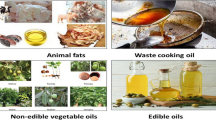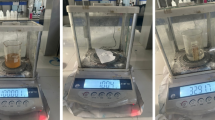Abstract
The formation of trans-fatty acids during the hydrogenation of oils using traditional methods is a known fact. Hydrogenation involves the conversion of unsaturation to saturation to enhance the kee** quality of oils. These trans-fatty acids are considered harmful leading to several cardiovascular diseases. Methods like the use of novel catalysts, interesterification, supercritical CO2 hydrogenation and electrocatalytic hydrogenation have been employed to reduce the trans-fatty acid formation. Recently, the application of cold plasma for hydrogenation was employed as an eco-friendly technology. The use of hydrogen as a feed gas will be the source of atomic hydrogen required for the conversion of unsaturated to saturated bonds. The hydrogenation using cold plasma did not result in the formation of trans-fatty acids. However, some reports have shown insignificant levels of trans-fatty acids and secondary lipid oxidation compounds after the plasma treatment. Therefore, it is necessary to optimize the plasma parameters, feed gas type and composition, processing condition to avoid practical implications. It can be concluded that after the detailed investigation of role of reactive species in the partial hydrogenation of oils cold plasma can be considered as an alternative technology.
Similar content being viewed by others
References
Adam M, Mossoba MM, Lee T (2000) Rapid determination of total trans-fat content by attenuated total reflection infrared spectroscopy: an international collaborative study. J Am Oil Chem Soc 77:457–462
Albertos I, Martín-Diana A, Cullen PJ, Tiwari BK, Ojha SK, Bourke P, Rico D (2017) Effects of dielectric barrier discharge (DBD) generated plasma on microbial reduction and quality parameters of fresh mackerel (Scomber scombrus) fillets. Innov Food Sci Emerg Technol 44:117–122
AOCS Official Method Cd 14d-99. Rapid Determination of Isolated trans Geometric Isomers in Fats and Oils by Attenuated Total Reflection Infrared Spectroscopy
Beers AEB (2007) Low trans hydrogenation of edible oils. Lipid Technol 19(3):56–58
Coenen JW (1976) Hydrogenation of edible oils. J Am Oil Chem Soc 53(6):382–389
Coutinho NM, Silveira MR, Rocha RS, Freitas MQ, Duarte MCK, Quero RF, da Cruz AG (2021) Cold plasma. Sustainable food processing and engineering challenges. Academic Press, pp 109–135
Devi Y, Thirumdas R, Sarangapani C, Deshmukh RR, Annapure US (2017) Influence of cold plasma on fungal growth and aflatoxins production on groundnuts. Food Control 77:187–191
Fridman A (2008) Plasma chemistry. Cambridge University Press
Gavahian M, Chu YH, Khaneghah AM, Barba FJ, Misra NN (2018) A critical analysis of the cold plasma induced lipid oxidation in foods. Trends Food Sci Technol 77:32–41
Hao H, Wu BS, Yang J, Guo Q, Yang Y, Li YW (2015) Non-thermal plasma enhanced heavy oil upgrading. Fuel 149:162–173
Jang ES, Jung MY, Min DB (2005) Hydrogenation for low trans and high conjugated fatty acids. Compr Rev Food Sci Food Saf 4(1):22–30
Jayasena DD, Kim HJ, Yong HI, Park S, Kim K, Choe W, Jo C (2015) Flexible thin-layer dielectric barrier discharge plasma treatment of pork butt and beef loin: effects on pathogen inactivation and meat-quality attributes. Food Microbiol 46:51–57
Johnson DR, Decker EA (2015) The role of oxygen in lipid oxidation reactions: a review. Annu Rev Food Sci Technol 6:171–190
Jung MY, Min D (2005) Novel hydrogenation for low trans fatty acids in vegetable oils. In: Lai O-M, Akoh C (eds) Healthful lipids. AOCS Publishing
Kim JS, Lee EJ, Choi EH, Kim YJ (2014) Inactivation of Staphylococcus aureus on the beef jerky by radio-frequency atmospheric pressure plasma discharge treatment. Innov Food Sci Emerg Technol 22:124–130
King JW (2014) Modern supercritical fluid technology for food applications. Annu Rev Food Sci Technol 5:215–238
Kongprawes G, Wongsawaeng D, Hosemann P, Ngaosuwan K, Kiatkittipong W, Assabumrungrat S (2021) Improvement of oxidation stability of fatty acid methyl esters derived from soybean oil via partial hydrogenation using dielectric barrier discharge plasma. Int J Energy Res 45(3):4519–4533
Lalvani SB, Mondal K (2004) U.S. Patent No. 6,825,367. Washington, DC: U.S. Patent and Trademark Office
Laverdura UP, Rossi L, Ferella F, Courson C, Zarli A, Alhajyoussef R, Gallucci K (2020) Selective catalytic hydrogenation of vegetable oils on lindlar catalyst. ACS Omega 5(36):22901–22913. https://doi.org/10.1021/acsomega.0c02280
Lee H, Yong HI, Kim HJ, Choe W, Yoo SJ, Jang EJ, Jo C (2016a) Evaluation of the microbiological safety, quality changes, and genotoxicity of chicken breast treated with flexible thin-layer dielectric barrier discharge plasma. Food Sci Biotechnol 25(4):1189–1195
Lee KH, Kim HJ, Woo KS, Jo C, Kim JK, Kim SH, Kim WH (2016b) Evaluation of cold plasma treatments for improved microbial and physicochemical qualities of brown rice. Lwt 73:442–447
Lu P, Cullen PJ, Ostrikov K (2016) Atmospheric pressure nonthermal plasma sources. Cold plasma in food and agriculture. Elsevier, pp 83–116
Mandal R, Singh A, Singh AP (2018) Recent developments in cold plasma decontamination technology in the food industry. Trends Food Sci Technol 80:93–103
Misra NN, Cheorun J (2017) Applications of cold plasma technology for microbiological safety in meat industry. Trends Food Sci Technol 64:74–86
Misra NN, Tiwari BK, Raghavarao KSMS, Cullen PJ (2011) Nonthermal plasma inactivation of food-borne pathogens. Food Eng Rev 3(3–4):159–170
Misra NN, Yadav B, Roopesh MS, Jo C (2019) Cold plasma for effective fungal and mycotoxin control in foods: mechanisms, inactivation effects, and applications. Compr Rev Food Sci Food Saf 18(1):106–120
Mondal K, Lalvani SB (2003) Mediator-assisted electrochemical hydrogenation of soybean oil. Chem Eng Sci 58(12):2643–2656
Na H, Mok C, Lee J (2020) Effects of plasma treatment on the oxidative stability of vegetable oil containing antioxidants. Food Chem 302:125306
Niemira BA (2018) Chapter 4. cold plasma processing to improve food safety. In: Proctor A (ed) Alternatives to conventional food processing. Royal Society of Chemistry, pp 138–152
Nurrulhidayah AF, Man CY, Rohman A, Amin I, Shuhaimi M, Khatib A (2013) Authentication analysis of butter from beef fat using Fourier Transform Infrared (FTIR) spectroscopy coupled with chemometrics. Int Food Res J 20(3):1383
Pedrow P, Hua Z, **e S, Zhu M-J (2020) Engineering principles of cold plasma. Advances in cold plasma applications for food safety and preservation. Elsevier, pp 3–48
Pérez-Andrés JM, Cropotova J, Harrison SM, Brunton NP, Cullen PJ, Rustad T, Tiwari BK (2020a) Effect of cold plasma on meat cholesterol and lipid oxidation. Foods 9(12):1786
Pérez-Andrés JM, de Alba M, Harrison SM, Brunton NP, Cullen PJ, Tiwari BK (2020b) Effects of cold atmospheric plasma on mackerel lipid and protein oxidation during storage. LWT 118:108697
Petukhov I, Malcolmson LJ, Przybylski R, Armstrong L (1999) Storage stability of potato chips fried in genetically modified canola oils. J Am Oil Chem Soc 76(8):889–896
Pintauro PN (2011) Electrocatalytic hydrogenation of edible oils. Hydrogenation of Fats and Oils. Elsevier, pp 279–304
Puprasit K, Wongsawaeng D, Ngaosuwan K, Kiatkittipong W, Assabumrungrat S (2020) Non-thermal dielectric barrier discharge plasma hydrogenation for production of margarine with low trans-fatty acid formation. Innov Food Sci Emerg Technol 66:102511
Sabat KC, Rajput P, Paramguru RK, Bhoi B, Mishra BK (2014) Reduction of oxide minerals by hydrogen plasma: an overview. Plasma Chem Plasma Process 34(1):1–23
Sarangapani C, Keogh DR, Dunne J, Bourke P, Cullen PJ (2017) Characterisation of cold plasma treated beef and dairy lipids using spectroscopic and chromatographic methods. Food Chem 235:324–333
Silveira MR, Coutinho NM, Esmerino EA, Moraes J, Fernandes LM, Pimentel TC, Cruz AG (2019) Guava-flavored whey beverage processed by cold plasma technology: bioactive compounds, fatty acid profile and volatile compounds. Food Chem 279:120–127
Sivakanthan S, Madhujith T (2020) Current trends in applications of enzymatic interesterification of fats and oils: a review. LWT 132:109880. https://doi.org/10.1016/j.lwt.2020.109880
Sutar SA, Thirumdas R, Chaudhari BB, Deshmukh RR, Annapure US (2021) Effect of cold plasma on insect infestation and kee** quality of stored wheat flour. J Stored Prod Res 92:101774
Thirumdas R, Sarangapani C, Annapure US (2015) Cold plasma: a novel non-thermal technology for food processing. Food Biophys 10:1–11
Thirumdas R, Trimukhe A, Deshmukh RR, Annapure US (2017) Functional and rheological properties of cold plasma treated rice starch. Carbohyd Polym 157:1723–1731
Thirumdas R, Kothakota A, Annapure U, Siliveru K, Blundell R, Gatt R, Valdramidis VP (2018) Plasma activated water (PAW): Chemistry, physico-chemical properties, applications in food and agriculture. Trends Food Sci Technol 77:21–31
Turner M (2016) Physics of cold plasma. U: Cold plasma in food and agriculture fundamentals and applications (Misra, NN, Schlüter, O., Cullen, PJ)
Upadhyay R, Thirumdas R, Deshmukh RR, Annapure U, Misra NN (2020) An exploration of the effects of low-pressure plasma discharge on the physico-chemical properties of chia (Salvia hispanica L.) flour. J Eng Process Manag 11(2):73–80
Van Durme J, Vandamme J (2016) Non-thermal plasma as preparative technique to evaluate olive oil adulteration. Food Chem 208:185–191
Van Durme J, Nikiforov A, Vandamme J, Leys C, De Winne A (2014) Accelerated lipid oxidation using non-thermal plasma technology: Evaluation of volatile compounds. Food Res Int 62:868–876
Wang T, Zhang X, Wang H, Yuan T, Yu D, Wang L, Jiang L (2019) Study on the electrochemical hydrogenation of soybean oil under H2 conditions. J Oleo Sci 68(4):311–320
Wang W-H, Liu X, Bao M (2020) Hydrogenation of fats and oils using supercritical carbon dioxide. Green sustainable process for chemical and environmental engineering and science. Elsevier, pp 347–356
Whitehead JC (2016) The chemistry of cold plasma. cold plasma in food and agriculture. Academic press, USA, pp 53–78
Yepez XV, Keener KM (2016) High-voltage Atmospheric Cold Plasma (HVACP) hydrogenation of soybean oil without trans-fatty acids. Innov Food Sci Emerg Technol 38:169–174
Yu D, Li X, Wang Y, Zou D, Hu L, Zheng H, Elfalleh W (2017) The influence of supercritical carbon dioxide (SC-CO 2) on electrolytes and hydrogenation of soybean oil. J Am Oil Chem Soc 94(7):993–1001
Yusem GJ, Pintauro PN (1992) The electrocatalytic hydrogenation of soybean oil. J Am Oil Chem Soc 69(5):399–404
Zaccheria F, Psaro R, Ravasio N, Bondioli P (2012) Standardization of vegetable oils composition to be used as oleochemistry feedstock through a selective hydrogenation process. Eur J Lipid Sci Technol 114(1):24–30
Zhu Y, Li C, Cui H, Lin L (2020) Feasibility of cold plasma for the control of biofilms in food industry. Trends Food Sci Technol 99:142–151
Funding
No funding were involved for this review.
Author information
Authors and Affiliations
Contributions
RT: Idea, writing, conceptualization, data collection.
Corresponding author
Ethics declarations
Conflict of interest
No conflict of interest.
Additional information
Publisher's Note
Springer Nature remains neutral with regard to jurisdictional claims in published maps and institutional affiliations.
Rights and permissions
About this article
Cite this article
Thirumdas, R. Partial hydrogenation of oils using cold plasma technology and its effect on lipid oxidation. J Food Sci Technol 60, 1674–1680 (2023). https://doi.org/10.1007/s13197-022-05434-z
Revised:
Accepted:
Published:
Issue Date:
DOI: https://doi.org/10.1007/s13197-022-05434-z




